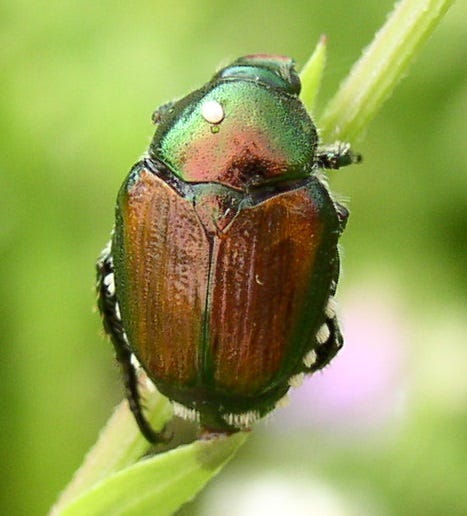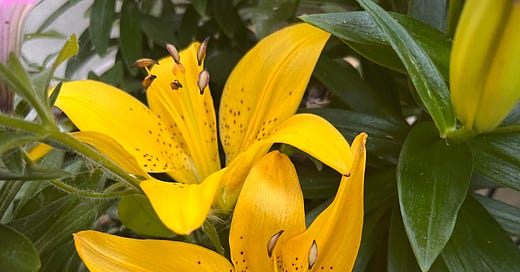Deer, beetles and lovely lilies
July in northern gardens means tragedies and joys abound. Plus your July to-do list.
I was 100 percent convinced that this year I had outsmarted the deer that frequent my community garden. In May, I installed a double fence — the first fence went around my 20 by 20 foot plot, then inside that fence was a 12 by 12 or so fence that circled the part of the garden where I was growing potatoes, green beans and peppers. The theory of the double fence is that deer are afraid they will get trapped and so will not breech the first fence. I was positive it would work.
It did not work.
I came home Sunday after a short trip to discover that the deer had jumped over both fences at once and munched down many of the beans and my favorite type of peppper. They left tracks so I know the damage was not done by rabbits — who actually seem detered by the fences.
What to do next? Because of the rules at my community garden, we are not allowed to put up fences higher than 3 feet. However, several gardeners have extended the illusion of a fence by adding a string about 3 feet above their fence. One even has flags on his string, which move in the wind and distract the deer. That will be my next tactic.
How do you deal with deer? Any and all suggestions welcome! Send me your best methods and I’ll put them together in a future newsletter.
Beetle battles

This is the time of year when many gardeners spot their first Japanese beetle. These can be incredibly troublesome pests, especially for those with roses, raspberries, fruit trees and other target plants. A couple of years ago, I wrote about the arrival of the winsome fly, a parasite that infects Japanese beetles and kills them. The beetles have been in Minnesota more than 50 years and numbers rise and fall from year to year. If you see a beetle with a fly on it, don’t kill it. The fly will do that for you and more flies will develop from the one you saved.
My townhome association has been dealing with a different destructive beetle — the viburnum leaf beetle. Its larva skeletonizes leaves in spring and early summer before dropping into the soil and transforming into a beetle. Since the beetles don’t always kill the shrubs, our strategy is to replace shrubs that are badly damaged with a different species of shrub. The methods for controlling the beetle otherwise are too complicated for many of our homeowners to undertake. Also, the more variety of shrubs and trees you have in a neighborhood, the better! Having too many of one kind of plant makes gardens more attractive to destructive insects. Diversity and variety are the way to go.
You can grow lilies in containers
After battling bunnies in a previous garden, I gave up on growing lilies in the ground. I use containers instead and they thrive! To hold the lilies from year to year, I put the bulbs in a large storage tote in our garage where I store potting soil from season to season. The bulbs do fine through the winter and they’ve grown like crazy this summer. A nice thing about having lilies in conatiners is that you can move them from place to place in the garden when you have a spot that needs brightening up. After the lilies bloom, move them to a more discrete spot where they can spend the rest of the summer as a green background.
July to-dos
Weeding, deadheading, a bit of pruning and montoring for pests. That’s your July chore list — that and spending as much time as you can walking through the garden. enjoying a cup of coffee or a glass of wine there and visiting with friends in the garden.
Enjoy!









